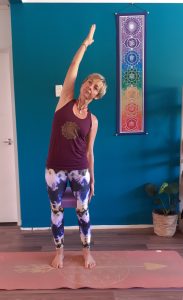25 Apr Yoga…..It’s not just about stretching and flexibility!
Yoga…..It’s not just about stretching and flexibility!
I have been a yoga teacher for about 20 years and yoga is an integral part of my life. Yoga has made me a lot more flexible and has had a healthy impact on my body and mind overall.
While, being “bendy” can look impressive, whether or not that equals ‘good yoga’ is another question…
In my earlier years of teaching and practising yoga I was over-stretching my body, and it did cause a few yoga-induced injuries. The more I continued to learn more about the science of muscles, joints, connective tissue, fascia etc…. it began to occur to me I might be doing too much yoga and way too much stretching.
Most ancient yoga teachings don’t advise taking yoga to the extreme. This moderation applies to every aspect of life: eating, socialising, meditating, practising asana.
This wisdom does often isn’t carried over into the modern-day view on mainstream yoga. We are bombarded with images of yogis in ever more extreme poses looking very radiant and peaceful.
What is ‘stretching’ anyway?
When coming into a stretch, the body responds first by a freeze reaction, known as the ‘stretch reflex’, in which the muscles initially protest against the strain. Depending on your condition and routine, this strain releases after about one to three minutes. Muscle is elastic by nature and when the stretch reflex subsides and the fibres of the muscle release, the muscle will go to a more lengthened state. This is the normal expansion and contraction of a muscle and therefore is not really a ‘stretch’. Once the ‘stretch’ is over, the muscle will contract again to its natural state. So nothing much has really structurally changed in the muscle.
However, it is different story with the connective tissue. After the stretch reflex releases, the fibres of connective tissue, which are less elastic, will start to ‘glide’ to a more extended, more lengthened state. In contrast to the muscles, the connective tissue fibres re-attach in this extended state.
Benefits of stretching
Stretching your body is a good thing. It is healthy for the muscles to be stretched and the myofascia to be under tension, especially when the body is well aligned. Stretching promotes circulation and therefore keeps the joints and muscles flexible and the body supple and vibrant. In addition, connective tissue is responsible for your body awareness. Supple and hydrated fascia give you a sense of spaciousness and connectedness to your body as the nerves in the fascia can optimally communicate with your brain.
The practice of yoga and stretching muscles certainly contribute to body awareness and overall good health. You can also enjoy these benefits without being able to put your legs behind your head!
Overstretching
In my experience, flexible people can be more at risk of injuring themselves than stiff people when practising yoga.
If you are naturally more “bendy” there is a tendency to bypass a core stability and integrity in your body. When stretching in a yoga pose, the strain is not isolated, but pulls on a whole system of connective tissue, which leaves them vulnerable to overstretching of the weaker parts.
Yoga practitioners striving for more and more flexibility increase their risk of tendon, ligament and joint overstretching, with many consequences.
My practice and how I teach has certainly changed and evolved over the years. I personally add more strength & stability poses and exercises in my own practice (sometimes using blocks, bands, weights, body weight) and my body has responded very positively to this. No more hip and lower back pain/niggles…which no amount of “stretching” seemed to help, in fact made it worse. My classes include more types of “mindful movement” for overall mobility of the whole body.
I am less inclined to “adjust” students these days as I don’t really know what is going on in their body and I like to teach people to become more aware their body with verbal “props”.
I will often get students to place a block between their legs in certain poses (to squeeze) to bring stability and more awareness/space into their lower body. Teaching them how to engage different muscles.
I like to begin classes with poses that engage muscles to stabilize your joints and muscles before actively stretching the body. Also poses and exercises that work our “pulling muscles” more. Many injuries can stem from the lack of proper engagement in the body.
Some teachers have only limited knowledge about the potential dangers of stretching and so may encourage students to move deeper into a pose than what may be healthy for them.
The next time you are encouraged to stretch yourself beyond your limit or feel you “should” be further in a pose, stop for a moment and consider what you are trying to achieve.
We can get so fixated on getting somewhere, becoming something, that we bypass ourselves and unconsciously put our health at risk.
We tend to forget that the most valuable part of our yoga practice is simply listening to our bodies.




No Comments